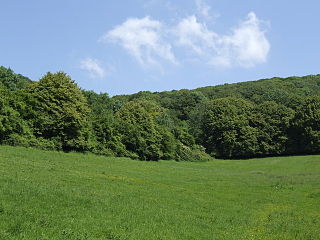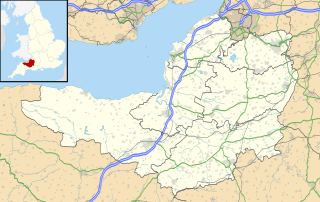Woodland Park and Pontpren is a Site of Special Scientific Interest in Rhondda Cynon Taf, south Wales. The site consists of three separate blocks of land, approximately 1 km south of the village of Penderyn.

A Site of Special Scientific Interest (SSSI) in Great Britain or an Area of Special Scientific Interest (ASSI) in the Isle of Man and Northern Ireland is a conservation designation denoting a protected area in the United Kingdom and Isle of Man. SSSI/ASSIs are the basic building block of site-based nature conservation legislation and most other legal nature/geological conservation designations in the United Kingdom are based upon them, including national nature reserves, Ramsar sites, Special Protection Areas, and Special Areas of Conservation. The acronym "SSSI" is often pronounced "triple-S I".

Rhondda Cynon Taf, or informally RCT, is a county borough in the south of Wales. It consists of five valleys: the Rhondda Fawr and Fach, Cynon, Taff and Ely valleys, plus a number of towns and villages away from the valleys. Results from the 2011 census showed 19.1% of its 234,410 residents self-identified themselves as having some ability in the use of the Welsh language.

Wales is a country that is part of the United Kingdom and the island of Great Britain. It is bordered by England to the east, the Irish Sea to the north and west, and the Bristol Channel to the south. It had a population in 2011 of 3,063,456 and has a total area of 20,779 km2 (8,023 sq mi). Wales has over 1,680 miles (2,700 km) of coastline and is largely mountainous, with its higher peaks in the north and central areas, including Snowdon, its highest summit. The country lies within the north temperate zone and has a changeable, maritime climate.
The Countryside Council for Wales states that the site has been categorisied as a Site of Special Interest "...for the Marsh Fritillary butterfly. Additional special interest is provided by its mixture of habitat types, including marshy grassland, dry acid and neutral grassland, heathland and woodland, which add to the ecological and biodiversity interest of the site and which also provide food and shelter necessary for the survival of the Marsh Fritillary." [1]

The Countryside Council for Wales, a Welsh Government Sponsored Body, was, until 31 March 2013, the wildlife conservation, landscape and countryside access authority for Wales. It was merged with Forestry Commission Wales, and Environment Agency Wales to form Natural Resources Wales, a single body managing Wales's environment and natural resources, on 1 April 2013.

The marsh fritillary is a butterfly of the family Nymphalidae. Commonly distributed in the Palearctic region, the marsh fritillary got its common name due to its habitat: marshy, damp wetlands and grasslands. The prolonged larval stage lasts for approximately seven to eight months and includes a period of hibernation over the winter. The larvae are dependent on the host food plant Succisa pratensis not only for feeding but also for hibernation, because silken webs are formed on the host plant as the gregarious larvae enter hibernation. Because female butterflies lay eggs in batches on the host plant, females are selective about the location of oviposition. The cost of laying the batches of eggs at an unfavorable location is high and extensive.
This page is based on this
Wikipedia article Text is available under the
CC BY-SA 4.0 license; additional terms may apply.
Images, videos and audio are available under their respective licenses.
Woodland Park can refer to:

Long Dole Wood and Meadows SSSI is a 9.8 hectares biological Site of Special Scientific Interest (SSSI) between the villages of Farrington Gurney and Hinton Blewitt in Bath and North East Somerset, notified in 1987.

Cheddar Wood is an 86.9-hectare (215-acre) biological Site of Special Scientific Interest at Cheddar in the Mendip Hills, Somerset, England, notified in 1967.

Barle Valley is a 1,540 acres (620 ha) Site of Special Scientific Interest within Exmoor National Park, situated in the counties of Devon and Somerset through which the River Barle flows. It was notified in its current form under the Wildlife and Countryside Act in 1988. The site includes the Somerset Wildlife Trust's Mounsey Wood Nature Reserve and the Knaplock and North Barton SSSI which has been notified since 1954.

Dunster Park and Heathlands is a 466.6 hectare biological Site of Special Scientific Interest in Somerset, notified in 2000.

Ruttersleigh is a 97 hectares biological Site of Special Scientific Interest between Buckland St Mary and Staple Fitzpaine on the north-facing slope of the Blackdown Hills. in Somerset, notified in 1991.

Twinhills Woods and Meadows is a 21.2 hectare biological Site of Special Scientific Interest on the Monarch's Way south of Dulcote in Somerset, notified in 1990.

Ditchling Common is a 66.5-hectare (164-acre) biological Site of Special Scientific Interest south-west of Wivelsfield in East Sussex. It is a country park. which is owned and managed by East Sussex County Council.

Castor Hanglands is an 89.8 hectare biological Site of Special Scientific Interest west of Peterborough in Cambridgeshire. The site is also a National Nature Reserve, and it is a Nature Conservation Review site, Grade I for its woodlands and Grade 2 for its grassland. It is common land managed by Natural England.

Park Corner Heath is a 2.9-hectare (7.2-acre) biological Site of Special Scientific Interest about 1.2 miles (2 km) south of East Hoathly, adjacent to the A22 main road between Uckfield and Eastbourne in East Sussex. It is managed by Butterfly Conservation.

Waun Ton-y-spyddaden is a Site of Special Scientific Interest in Brecknock, Powys, Wales. It is marshy grassland habitat with populations of marsh fritillary butterfly,

Mynydd Llangyndeyrn is a Site of Special Scientific Interest (SSSI) in Carmarthen & Dinefwr, Wales, and a hill reaching 263 metres, which is a Marilyn.

Brynna a Wern Tarw is a Site of Special Scientific Interest located around Brynna in Rhondda Cynon Taf and Pencoed in Bridgend, south Wales.

Caeau Cefn Cribwr is a Site of Special Scientific Interest near Cefn Cribwr in Bridgend, south Wales.

Waun Cimla, also known as Bedford Park is a Site of Special Scientific Interest in Glamorgan, south Wales. It contains the Cefn Cribwr Ironworks and some 40 acres of woodlands and meadows.

Saltbox Hill is a 22.2 biological Site of Special Scientific Interest in three separate areas in Biggin Hill in the London Borough of Bromley. One area of 6.9 hectares is owned and managed by the London Wildlife Trust. It is also a Site of Metropolitan Importance. It is a steeply sloping 55 acre biological site, which is close to Charles Darwin's home, Down House, and inspired him and provided him with a picnic place.

Upper Wye Gorge is a Site of Special Scientific Interest (SSSI), noted for its biological and geological characteristics, around Symonds Yat in the Upper Wye Valley on the Wales–England border. The site is listed in the 'Forest of Dean Local Plan Review' as a Key Wildlife Site (KWS).

Minchinhampton Common is a 182.7-hectare (451-acre) biological and geological Site of Special Scientific Interest in Gloucestershire, notified in 1972.

Gweunydd Blaencleddau is a large wetland complex in a shallow south-west valley around the headwaters of the Eastern Cleddau river. It is a Site of Special Scientific Interest (SSSI) and a Special Area of Conservation (SAC) situated in Pembrokeshire, South Wales.

Wallis Moor is a Site of Special Scientific Interest 12 km to the north of Haverfordwest near the village of Ambleston in Pembrokeshire, South Wales. It has been designated as a Site of Special Scientific Interest since March 1998 in an attempt to protect its fragile biological elements. The site has an area of 63.22 hectares and is managed by Natural Resources Wales.



















